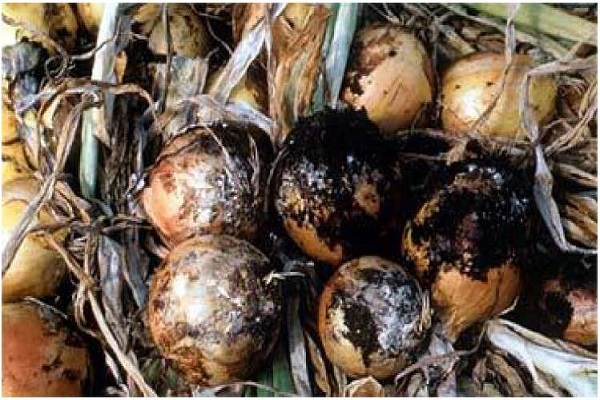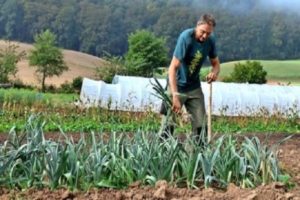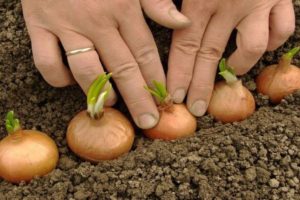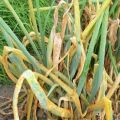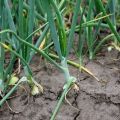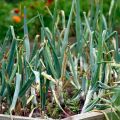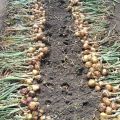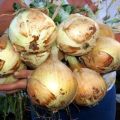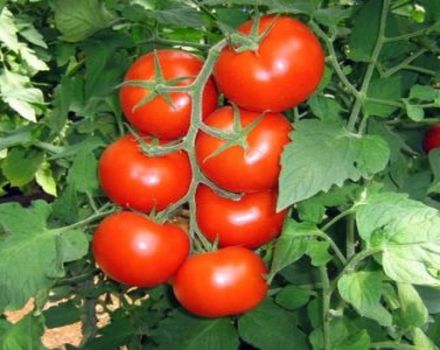Description and treatment of onion diseases, control measures and what to do
To prevent onion diseases from causing significant damage to the crop, you need to know preventive measures, rules for growing and care, as well as ways and means of combating them. Knowing the description of onion diseases, you can also carry out the correct treatment.
Onion neck rot
The causative agent of cervical rot is a fungal infection. Often the disease affects unripe bulbs or crops that have been in moist soil for a long time.
A characteristic feature is the softening of the neck of the bulb, its thinning and rotting. A gray fluffy bloom and an unpleasant odor appear. Gradually, the plaque turns into small black grains, which merge with each other. If you do not start fighting the disease, plaque will cover the entire bulb.
If infected bulbs are planted, feathers will grow weak, pale green in the future. The inflorescences do not reach the ripening stage, become moldy and lower their heads down.
The main agrotechnical measures to combat the disease are:

- for planting, you need to choose varieties resistant to fungus;
- after harvesting, the site is freed from all waste;
- weeding, watering the beds is carried out carefully, without damaging the feathers;
- do not overdo it with nitrogen fertilizers;
- you need to harvest in dry weather, drying the harvested bulbs for at least two weeks;
- the leaves of the harvested onion do not need to be cut too short, it is recommended to leave a stump of 3-4 cm.
- only whole, large and dense heads are selected for storage, without damage;
- it is advisable to process the planting material with special solutions.
If onion neck rot has already appeared, chemical control measures will help. Treatment with fungicides such as Tigam, Benlat, Fundazol helps. During the formation of the heads, the beds are watered using the Effekton preparation. For foliar treatment, you can use a solution of copper sulfate or Bordeaux liquid.
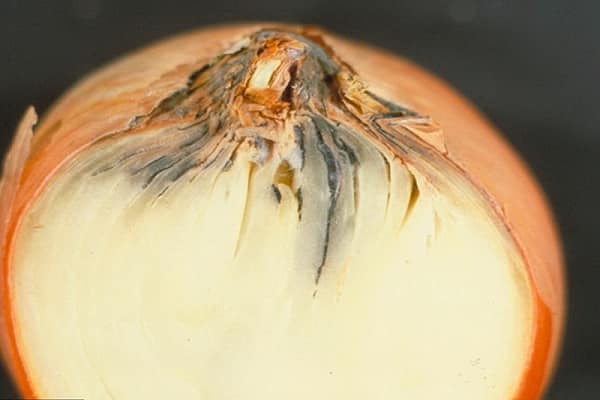
Downy mildew
The fungal disease downy mildew spreads favorably after prolonged rains or if watering rules are not followed. The affected feathers of the vegetable look sluggish, drooping, lose color saturation. Gradually, the leaves become covered with brown-yellow spots, dry out and the plant dies.
Onion pests such as aphids and whiteflies contribute to the spread of infection. They spread spores to healthy plants and the disease is rapidly gaining traction.
Preventive measures to combat the disease are:

- vegetable beds need to be weeded out;
- since the fall, they begin to prepare the land allotted for planting onions: they dig up, apply fertilizers, disinfect;
- seedlings can be sprayed with a solution of Bordeaux liquid;
- in a rainy, cool summer, it is useful to process vegetable beds with such biological products as Fitosporin, Planriz, Gamair.
For soil disinfection, you can use a solution of copper sulfate, Fitosporin, Alirin, Gamair, Baikal-Em. You can process the onion from the powdery mildew that has appeared with such means as Thanos, Ridomil, Vectra, Topaz.
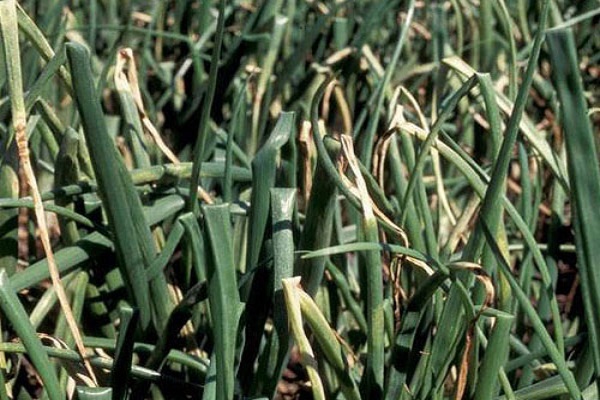
Onion rust
Signs of fungal rust infection are wilting, drying and yellowing of the leaves. The bulb is small and poorly stored. On the leaves affected by the disease, tubercles of an orange-yellow or brown-reddish color appear. Gradually, the feathers begin to die off.
Spores of fungal infection tolerate cold well and hibernate on plant debris. That is why it is recommended to remove the remaining tops from the garden at the end of the growing season. Rust development is also facilitated by cool, rainy summers, too dense plantings and an excess of nitrogen in the soil.

What to do if feathers are covered with plaque and other signs of rust appear? Most often, the disease develops at the end of summer, so it is important to inspect your plantings daily. In case of a problem, you need to stop watering the beds and the introduction of nitrogenous fertilizers. Damaged stems are cut and removed away from the site.
If signs of the disease were found, the vegetable crop should be treated with fungicides. Folikur, Ordan, Topaz are considered effective. The drug Hom, Tilt or simple Furacilin copes well with the disease.
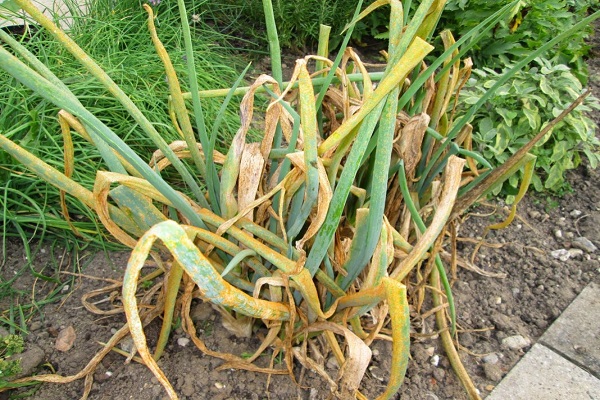
Fusarium
Common ailments of onions include the fungal disease Fusarium. The appearance of the first signs is evidenced by yellowing and wilting of the leaves. Initially, the tops of the feathers are affected, gradually rotting spreads to the entire length of the leaves. Often the bulb itself is rotting... It becomes watery, softened and smells unpleasant. A pinkish fungal bloom forms at the bottom of the bulb.
The provoking factors are an excess of moisture in the soil, untimely harvesting, poor-quality planting material, too dense planting.
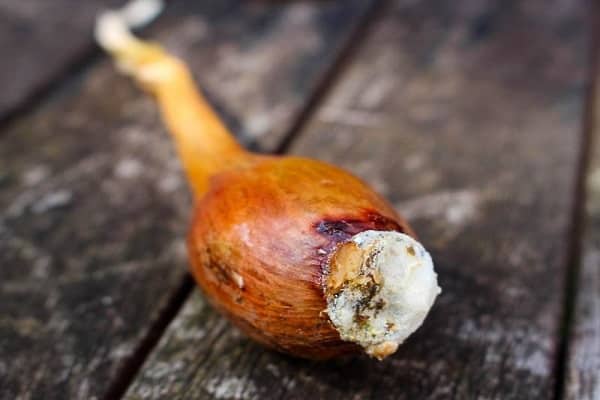
Preventive control measures are considered correct preparation of the soil and seed material. It is recommended to treat the soil with copper sulfate or such a preparation as Iprodion. Disinfection of planting material is carried out with a solution of the drug Fitosporin, Quadris or Fundazol, it can be soaked in a weak solution of potassium permanganate.
If signs of illness are found, it is necessary to remove the affected plants from the garden and burn them, and process the remaining vegetables, for example, with Fitosporin.
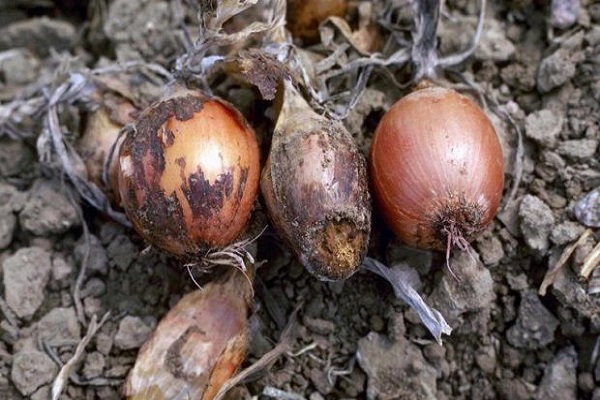
Bacterial onion rot
Bacterial rot penetrates the wounds that form on the leaves during weeding or watering. The first signs of rot infection are visible on the leaves. Light spots first appear on them, then they increase in size and reach the neck. After rain, watering or dew, bacteria penetrate deep into the soil to the head of the onion.
In contrast to the bulbs, which are affected by rot of the bottom of the onion (fusarium), the heads with this disease may look healthy in appearance. But when you cut it, you can see that the core is completely rotten. Rotting gradually spreads from the center to the edges of the head.

Prevention and control of the disease consists in observing the following rules:
- it is not recommended to plant onions in the same place for several years in a row;
- after harvesting, all plant residues must be removed from the garden;
- all work on the garden must be done carefully, without injuring the feathers of the onion;
- monitor the regularity of watering, from the moment the bulb forms, they should be moderate;
- loosening the soil slows down the spread of the disease;
- apply fertilizers in accordance with the norms (an excess of nitrogen becomes the cause of infection activity).

The vectors of infection are pests such as onion fly, spider mite. Therefore, preventive measures should also be aimed at pest control.
So that bacterial rot does not appear in the planting material, it is kept for several hours in a solution of formalin or potassium permanganate. Then dry well in the sun. Suspicious bulbs are treated with antibiotics. A mixture of tetracycline with streptomycin is suitable.
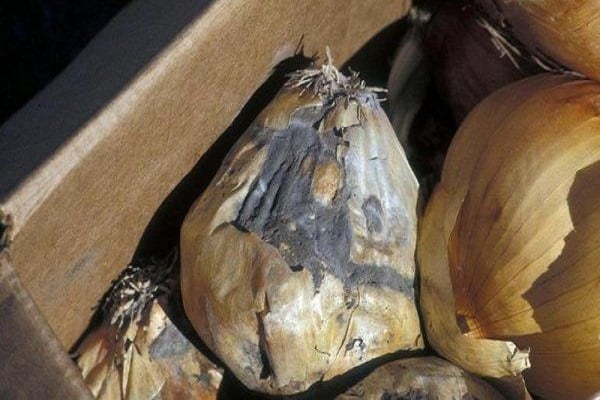
Green mold rot
Green mold rot affects already harvested crops during storage. The onion shell dries up and becomes covered with green mold. The main reasons are: damage to the bulbs during harvest and high humidity in the room where the crop is stored (more than 70%).
Onion pests often cause the development of the disease. They still infect the plant in the beds, and under favorable conditions, pathogens begin to actively develop, leading to rotting of the crop.
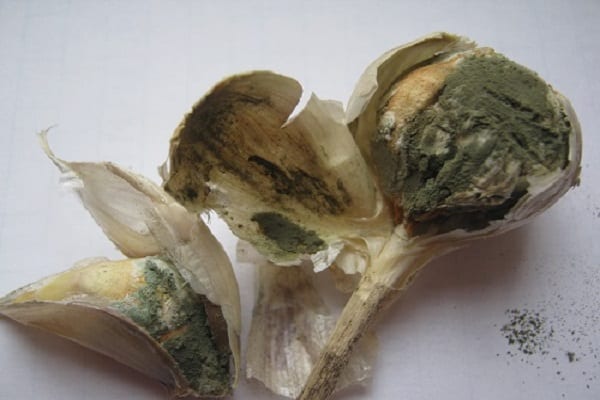
Infected bulbs develop watery brownish spots near the bottom. After a while, an unpleasant mold smell appears from them, and a greenish bloom is observed under the scales.
Preventive measures are considered to be thorough drying of the crop and compliance with all requirements for its storage. The room should be dark, cool (about +3 degrees) and not damp. Pre-disinfection of the place for onion storage.
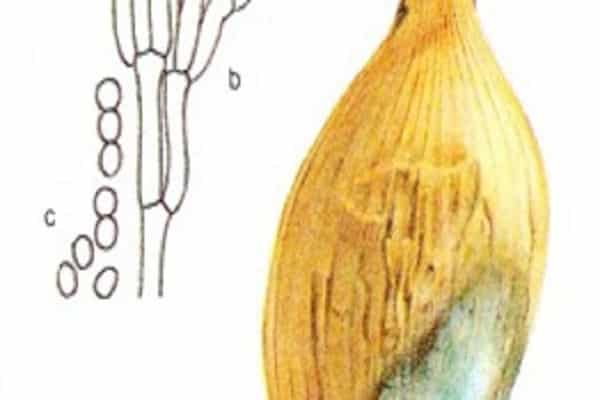
It is recommended to select bulbs in advance for planting next year. Tip: Take seed material for storage in another place. Review it periodically and get rid of diseased and damaged bulbs in time.
Black mold rot
Fungal disease black mold rot is mainly a problem of harvested crops that have been stored. Diseased bulbs become soft, rot, deformed, the scales dry out and become covered with black bloom. But you can see signs in the garden. Fungal spores infect leaves when they are wet for more than 7 hours.
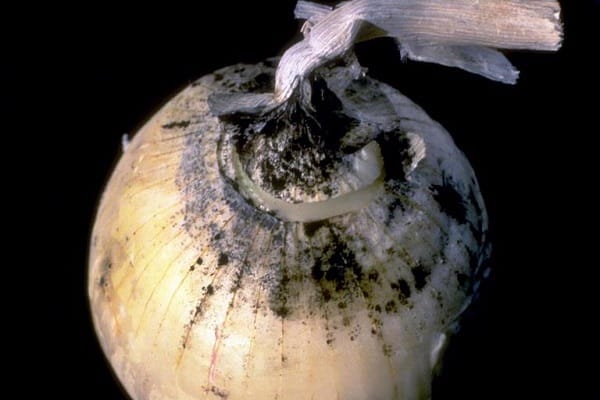
The development of the disease is provoked by improper storage conditions. Black onion mold develops in musty, damp areas where humidity is high, temperature fluctuations are high, and air ventilation is poor. An insufficiently dried crop after digging out of the soil provokes the disease.
Protection measures are:
- during loosening and weeding of the soil, care must be taken so as not to damage the leaves, otherwise the wound can become a site of infection;
- the harvested crop should be protected from damage;
- keep low air humidity and low temperature indoors;
- remove old tops of plants from the garden;
- since onion pests become the cause of the disease, it is not necessary to allow them to appear in the garden.

Harvesting must be done in a timely manner. Unripe or too overripe onions should not be removed. It will be poorly stored and a high risk of developing various diseases.
